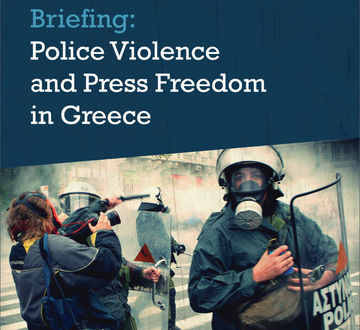
Inadequate police internal investigations hobble criminal prosecution, analysis indicates
Link: IPI
While a wave of police violence against photojournalists in Greece appears to have ebbed in recent months, the overwhelming majority of past incidents remain mired in impunity, a report released today by the International Press Institute (IPI) has found.
Statistics kept by the Hellenic Photojournalists’ Union (EFE) and included in the report indicate that just one of 16 incidents of police aggression against photojournalists between 2010 and 2014 has resulted in legal consequences. In the majority of cases authorities have failed to even identify the perpetrator.
The report, authored by Dr. Eleni Polymenopoulou of Brunel University, analyses the legal and structural factors that have combined to obstruct justice. According to the analysis, prosecutions of alleged police violence against photojournalists “tend to stall at the pre-investigation phrase”, a phenomenon that “appears to be related not to the unwillingness of prosecutors to initiate proceedings, but to the unwillingness of the police to cooperate”.
In particular, prosecutors rely on evidence supplied by internal police department investigations, or “sworn administrative inquiries” (SAI). Such inquiries are supposed to take place following all instances of alleged police abuse, but “in practice are initiated only after an incident receives publicity”, the report found. Even those inquiries that may eventually take place, the report suggests, are hobbled by the institutional culture inside the police and difficulties in identifying the perpetrator. EFE President Marios Lolos, in an interview for the report, stated that while police officers are legally obliged to carry identification, “these signs either do not exist, or are not readable”.
The failure of internal disciplinary and evidentiary mechanisms has meant that public prosecutors have been forced to drop charges even in incidents that resulted in serious injuries. Lolos himself was hospitalised with severe head trauma after a police officer struck him with a baton in April 2012 – the bruise from the incident can still be felt today. The perpetrator in that case, as in two other incidents involving Lolos, in 2010 and 2011, remains unknown.
According to EFE, an October 2011 incident in which a police officer punched photojournalist Tatiana Bolari in the face is the only one that has resulted in punishment. The officer involved was handed an eight-month suspended prison term, a sentence EFE says will have “no impact” on his career.
Though questions of police violence in Greece are not new – the report makes note of a series of successful claims involving police brutality against Greece at the European Court of Human Rights – incidents involving journalists and photographers are considered to have increased in the context of the country’s ongoing financial and social crisis. Most of the photographers who suffered police aggression were attempting to cover anti-government protests; in a few cases, police are accused of failing to protect photojournalists from physical attacks by members of the extreme-right-wing Golden Dawn party.
“It is extremely concerning that the Greek authorities have failed to hold those responsible for violence against photojournalists, who play a key role in informing the Greek public about the events and repercussions of the ongoing crisis,” IPI Director of Press Freedom Programmes Scott Griffen said. “And it is of equal concern that the structural flaws that have encouraged impunity in such cases appear not to have been addressed. The failure to ensure individual and systemic accountability obviously raises the possibility that similar events will continue to occur in the future.”
Griffen urged the Greek authorities to adopt the report’s recommendations. In addition to ending impunity, these include restructuring SAIs to ensure impartiality and effectiveness, enforcing rules on police identification badges and providing human-rights training to officers.
The report also scrutinises the alleged police abuse of a procedure called prosagoges, in which law enforcement officials may take to a station for questioning any persons believed to be lacking sufficient identification or suspected of having committed a crime due to “place, time, circumstances and behaviour”. Greek Journalist groups referenced in the report say that reporters and photoreporters have been increasingly hauled away for questioning by police despite displaying valid press cards.
In one recent case, two journalists and two photojournalists attempting to cover the removal of refugees at the border between Greece and the Former Yugoslav Republic of Macedonia (FYROM) / Republic of Macedonia were arrested and taken to a local police station ostensibly in order to verify their identities.
Anastassia Tsoukala, EFE legal adviser, told Dr. Polymenopoulou that the apparent increase in the use of prosagoges came as the number of demonstrations and corresponding incidents of violence against the press had decreased over the past year. Prosagoges, she said, “is the logic of intimidation: [The police] need to show [they] can take you in at any moment”.
Police violence was a key topic of IPI’s November 2015 mission to Greece, carried out with the South East Europe Media Organisation (SEEMO).
Click to read or download the report "Briefing: Police Violence and Press Freedom in Greece".
Questa pubblicazione è stata prodotta nell'ambito del progetto European Centre for Press and Media Freedom, cofinanziato dalla Commissione europea. La responsabilità sui contenuti di questa pubblicazione è di Osservatorio Balcani e Caucaso e non riflette in alcun modo l'opinione dell'Unione Europea. Vai alla pagina del progetto

 New report highlights impunity for police violence against Greek photojournalists
New report highlights impunity for police violence against Greek photojournalists




 Tutti i contenuti disponibili sul sito di Osservatorio Balcani e Caucaso sono distribuiti con licenza
Tutti i contenuti disponibili sul sito di Osservatorio Balcani e Caucaso sono distribuiti con licenza 